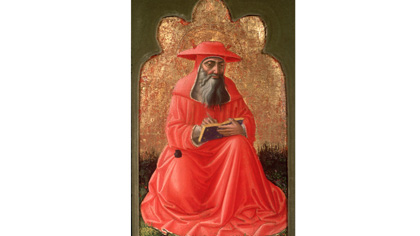St. Jerome

St. Jerome, Second half of the 15th century
Niccolò di Liberatore da Foligno, called l'Alunno
Italian
Tempera and gold on panel
Gift of Mrs. Chester D. Tripp, 1978-20
Saint Jerome is the patron saint of students and libraries and was one of the Four Fathers of the Western Church. The D'Arcy's painting portrays Jerome with a long grey beard, wearing the brilliant red robe and hat of a cardinal. Though he is often depicted in this manner, Jerome never officially served as cardinal since the office did not exist in his time. His cardinal's frock may allude to the appointment which he held under Pope Saint Damasus I.
Saint Jerome is seated in a field of grass and flowers, hard at work writing. He revised and translated the Bible from its Greek and Hebrew sources into the Latin Vulgate, the version on which all subsequent Bibles are based. Jerome had a vision in which he was reprimanded by Christ for his study of pagan literature, after which he took refuge in the desert for four years and studied Hebrew.
St. Jerome has been attributed to Niccolò di Liberatore da Foligno (l'Alunno), an Italian painter from a family of artists. L'Alunno was active in and around Assisi and is considered one of the most important Umbrian artists of his day. One of his prestigious commissions was the altarpiece for the high altar of the Duomo of Assisi (now Museo Capitolare di San Rufino, Assisi). L'Alunno was strongly influenced by the work of Benozzo Gozzoli, and St. Jerome was at one time attributed to Gozzoli.
St. Jerome, Second half of the 15th century
Niccolò di Liberatore da Foligno, called l'Alunno
Italian
Tempera and gold on panel
Gift of Mrs. Chester D. Tripp, 1978-20
Saint Jerome is the patron saint of students and libraries and was one of the Four Fathers of the Western Church. The D'Arcy's painting portrays Jerome with a long grey beard, wearing the brilliant red robe and hat of a cardinal. Though he is often depicted in this manner, Jerome never officially served as cardinal since the office did not exist in his time. His cardinal's frock may allude to the appointment which he held under Pope Saint Damasus I.
Saint Jerome is seated in a field of grass and flowers, hard at work writing. He revised and translated the Bible from its Greek and Hebrew sources into the Latin Vulgate, the version on which all subsequent Bibles are based. Jerome had a vision in which he was reprimanded by Christ for his study of pagan literature, after which he took refuge in the desert for four years and studied Hebrew.
St. Jerome has been attributed to Niccolò di Liberatore da Foligno (l'Alunno), an Italian painter from a family of artists. L'Alunno was active in and around Assisi and is considered one of the most important Umbrian artists of his day. One of his prestigious commissions was the altarpiece for the high altar of the Duomo of Assisi (now Museo Capitolare di San Rufino, Assisi). L'Alunno was strongly influenced by the work of Benozzo Gozzoli, and St. Jerome was at one time attributed to Gozzoli.
